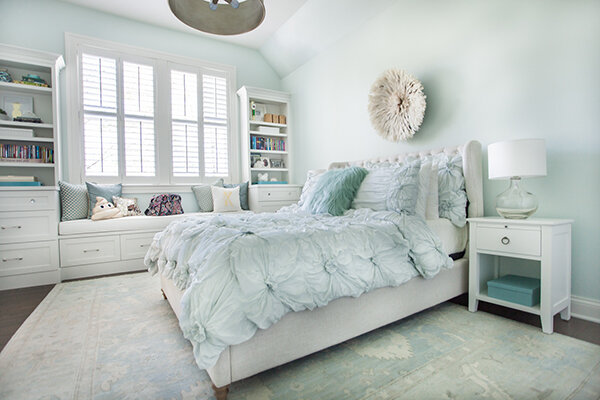Planning for a nursery, preparing to move on to a “big boy room”, growing into a tween space or even setting up a room for a high schooler that you hope will stand the test of time are all fun design projects for parents and kids alike. When designing a room for a child, we take into consideration their unique needs and style while balancing how to keep the room in line with the aesthetic of the home and letting it reflect the interests of the child. This balancing act changes with each child, each parent and each home, but generally speaking, these are the top considerations to keep in mind.
Consider how the room will be lived in. Unlike an adult’s room, a kid’s room often provides more than a place to rest. It may also be a place to play, to study, to entertain friends and maybe even tune in to e-learning. Considering each activity informs the floor plan, furniture choices and organizational needs.
With a built-in window seat to snuggle up with a book (or device), bookcases for open storage and drawers for hidden storage, this room is set up be fit for the current and future needs of this teenager.
Allow some creative freedom to express personal style. The amount of creative freedom can greatly vary by the interest of the child. Some kids love to be involved in picking elements of their room and others may take less interest. Either way, we have found that it helps to first narrow down the choices to all things that you would be happy with if they picked. Then, within that playground, their involvement can be a lot of fun. When we discuss the overall look and feel of the room, we absolutely want the child to be excited. When we get into details, it can be fun to set aside a few items that are “kid’s choice”.
The little girl who lives here added the ballerina elephant - the perfect final touch. The mom who lives here loved the vivid colors of the upholstered headboard and custom pillow. The combo is a win-win.
Evaluate ways the room can grow with them. From flexible furniture to adjustable storage and updatable accessories, thinking about the next step for the room is always helpful. This may include a crib that converts to a toddler bed. This could be a bookcase that holds a few baskets of toys now, a stuffed animal collection next and text books down the road. Frames with the ability to change the pictures or artwork can allow for simple updates. We tend to steer clear of overly themed kid’s rooms, but weaving in a child’s interests in ways that can be updated when their interests change is worth considering.
A desk can provide a place to color, do homework, display inspiration or even become a little vanity to keep makeup when the timing makes sense.
Include “just enough” storage and plenty of organization. Kids tend to fill up as much storage as available. Like a goldfish, their stuff just seems to grow into the amount of space it has! By including as much storage as makes sense, you limit the amount of clutter that inevitably ends up on their floor. At the same time, providing simple ways to keep their treasures organized can be very helpful. This could include built-in storage with shelving or drawers. Or, this could mean outfitting a closet with storage for more than clothes. Having a hook or set of hooks to display metals or ribbons helps keep them from hanging on door knobs or curtain rods. A magnet board to display pictures, schedules or notes keeps them from piling up (or getting taped to the wall!). There are plenty of ways to get ahead of the mess - all depending on the needs of the child.
The custom magnet board fabric not only coordinates with the bedding, but it give these girls a place to display their own artwork. The basket may look nice, but it is hiding a collection of stuffed animals.
Don’t be concerned about leaving the room “unfinished”. A kid’s room is always a work in progress. They may bring home a piece of art from school that could be framed in their rooms. A friend or family member may gift them a new treasure to be displayed. They could pick up a souvenir on a trip and it may change what they display on a shelf. Or, they may decide that they have to have twinkle lights. As we talked about the big elements of their room being able to evolve, the little stuff can be ever changing.
All-in-all, we love how a child’s face can light up when they love their room. It is their own personal home within their home and letting it grow with them, include all the function they need and the style they want can make it a special place.
The treasures on these shelves may change time after time. But, with the built-in structure and flexibility, these sisters will be able to settle into this cozy spot with their favorite things nearby for years.





